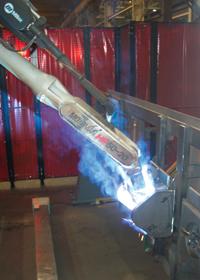- FMA
- The Fabricator
- FABTECH
- Canadian Metalworking
Categories
- Additive Manufacturing
- Aluminum Welding
- Arc Welding
- Assembly and Joining
- Automation and Robotics
- Bending and Forming
- Consumables
- Cutting and Weld Prep
- Electric Vehicles
- En Español
- Finishing
- Hydroforming
- Laser Cutting
- Laser Welding
- Machining
- Manufacturing Software
- Materials Handling
- Metals/Materials
- Oxyfuel Cutting
- Plasma Cutting
- Power Tools
- Punching and Other Holemaking
- Roll Forming
- Safety
- Sawing
- Shearing
- Shop Management
- Testing and Measuring
- Tube and Pipe Fabrication
- Tube and Pipe Production
- Waterjet Cutting
Industry Directory
Webcasts
Podcasts
FAB 40
Advertise
Subscribe
Account Login
Search
Fabricator meets competition challenge with welding robot cells
- January 15, 2009
- Article
- Automation and Robotics
Situation
LB Steel LLC/Coburn Steel Products is a privately held fabricating and machining company with about 300 employees and multiple plants. Approximately 350,000 sq. ft. of its 500,000-sq.-ft. facility in Harvey, Ill., is dedicated to fabrication.
Most of the welding the company does involves large, heavy components for the construction, railroad, and mining industries, as well as various OEMs. Materials used include carbon steel, stainless steel, mild steel, A36 or high-strength alloy steel, and aluminum and range from light 10- or 12-ga. metal to steel up to 4 in. thick. To improve productivity and quality, the company looked to robotic automation.
"Except for one older robot, all the welding in the plant was being done manually," said Mike Powers, manufacturing engineer. "The old robot had some reliability issues and was costly to run in terms of both consumables and replacement parts. Programming had to be done by a representative from the manufacturer, which also was costly," he explained.
Resolution
In early 2006 the company implemented a modified Motoman FabWorld® robotic welding system at its Harvey facility that consists of an HP50-20 robot with a 44.1-lb. payload, 122.3-in. reach, and 0.006-in. repeatability. The extended-reach robot rides on a 6-ft.-long, three-position pneumatic shuttle track located between two heavy-duty MHT3000 headstock/tailstock positioners, which have a maximum payload of 13,889 lbs. and a 39.4-in. maximum sweep radius.
In early 2007 the company added a stand-alone HP50-20 robot at the Harvey facility that primarily does multipass welding on parts that are located on stationary tables. This cell is used to produce a large volume of parts used in large man-way portals for a major mining company.
"Welding the parts manually would take anywhere from 10 to 12 man-hours; using the robot, they can be welded in 21⁄2 to 3 hours," said Powers.
Also in early 2007, the company implemented an ArcWorld® 4000 cell at its 100,000-sq.-ft. facility in Chicago Heights, Ill. The system includes an EA1900N Expert Arc welding robot with a 6.6-lb. payload and 75-in. reach with ±0.003-in. repeatability.
All three of the robotic welding cells are running one shift, five or six days a week. "A lot of the weldments we make are being machined after they are welded. We try to build parts with specific gauge stops and use key datum points for references. Using those points all the way through helps us get consistent parts and makes for better repeatability," Powers said. "With that in mind, the robots also have seam tracking and touch sensing. Using that combination, we can end up with some pretty productive welding," he explained.
Related Companies
subscribe now

The Fabricator is North America's leading magazine for the metal forming and fabricating industry. The magazine delivers the news, technical articles, and case histories that enable fabricators to do their jobs more efficiently. The Fabricator has served the industry since 1970.
start your free subscription- Stay connected from anywhere

Easily access valuable industry resources now with full access to the digital edition of The Fabricator.

Easily access valuable industry resources now with full access to the digital edition of The Welder.

Easily access valuable industry resources now with full access to the digital edition of The Tube and Pipe Journal.
- Podcasting
- Podcast:
- The Fabricator Podcast
- Published:
- 04/16/2024
- Running Time:
- 63:29
In this episode of The Fabricator Podcast, Caleb Chamberlain, co-founder and CEO of OSH Cut, discusses his company’s...
- Trending Articles
AI, machine learning, and the future of metal fabrication

Employee ownership: The best way to ensure engagement

Steel industry reacts to Nucor’s new weekly published HRC price

Dynamic Metal blossoms with each passing year

Metal fabrication management: A guide for new supervisors

- Industry Events
16th Annual Safety Conference
- April 30 - May 1, 2024
- Elgin,
Pipe and Tube Conference
- May 21 - 22, 2024
- Omaha, NE
World-Class Roll Forming Workshop
- June 5 - 6, 2024
- Louisville, KY
Advanced Laser Application Workshop
- June 25 - 27, 2024
- Novi, MI



























